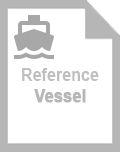Chronometer from the Rebecca R. Douglas Schooner
Title:
Chronometer from the Rebecca R. Douglas Schooner
Subject:
Description:
The photo above and the information that follows is from Andrew Baron of Santa Fe, New Mexico.
The ship’s two survivors were rescued on May 2, while the boat went down on April 28 near Cape May New Jersey. Depending on the weather, this means the schooner would likely have sailed out of New York (where its chronometer was calibrated on April 16) on April 26 or 27, only a week and half or so after the chronometer’s certification.
I have the ship's marine chronometer (precision ship's clock shown in the photo above) from the Rebecca R. Douglas, well preserved and working, along with a verified vintage calibration certificate (timekeeping accuracy tested, calibrated and certified by an established chronometer firm) dated April 16, 1943, only two weeks before this schooner went down. This would likely have been done in preparation for its last journey. It's a mystery how the clock and its certificate survived when the ship did not.
Given the date of the demise of the Rebecca R. Douglas, I can only assume that it had more than one chronometer, leaving one behind in New York and sailing with another. There’s more I want to learn about this however; the need of the navigator to definitely have a chronometer on board, to plot longitude on a north-to-south passage through coastal waters, how long a chronometer would remain with the certifying company after certification, prior to boarding ship, whether a coastal schooner like the RR Douglas would have had more than one chronometer, the prevailing weather at the time of the accident, whether U-boats that were observed off US coasts were in the area at that time, and the names of the two survivors long with the names of those who perished when the schooner went down.
This last detail might possibly make the survival of this artifact of some importance to descendants of the victims and survivors. If any of them had young children at that time, they may still be living. This unusual survivor may be all of significance that remains of the tangible material associated with that boat, apart from the photo in your library collections.
During wartime every viable old chronometer that could be found was reconditioned and pressed into service for the Navy and Merchant Marine, to augment new ones made to meet the increased demand for navigational aids. When this chronometer, made by Thomas Porthouse, ca. 1850 in London, was assigned to the Rebecca R. Douglas, it was already close to a century old, and yet its accuracy could still be certified for ongoing service at sea.
The ship’s two survivors were rescued on May 2, while the boat went down on April 28 near Cape May New Jersey. Depending on the weather, this means the schooner would likely have sailed out of New York (where its chronometer was calibrated on April 16) on April 26 or 27, only a week and half or so after the chronometer’s certification.
I have the ship's marine chronometer (precision ship's clock shown in the photo above) from the Rebecca R. Douglas, well preserved and working, along with a verified vintage calibration certificate (timekeeping accuracy tested, calibrated and certified by an established chronometer firm) dated April 16, 1943, only two weeks before this schooner went down. This would likely have been done in preparation for its last journey. It's a mystery how the clock and its certificate survived when the ship did not.
Given the date of the demise of the Rebecca R. Douglas, I can only assume that it had more than one chronometer, leaving one behind in New York and sailing with another. There’s more I want to learn about this however; the need of the navigator to definitely have a chronometer on board, to plot longitude on a north-to-south passage through coastal waters, how long a chronometer would remain with the certifying company after certification, prior to boarding ship, whether a coastal schooner like the RR Douglas would have had more than one chronometer, the prevailing weather at the time of the accident, whether U-boats that were observed off US coasts were in the area at that time, and the names of the two survivors long with the names of those who perished when the schooner went down.
This last detail might possibly make the survival of this artifact of some importance to descendants of the victims and survivors. If any of them had young children at that time, they may still be living. This unusual survivor may be all of significance that remains of the tangible material associated with that boat, apart from the photo in your library collections.
During wartime every viable old chronometer that could be found was reconditioned and pressed into service for the Navy and Merchant Marine, to augment new ones made to meet the increased demand for navigational aids. When this chronometer, made by Thomas Porthouse, ca. 1850 in London, was assigned to the Rebecca R. Douglas, it was already close to a century old, and yet its accuracy could still be certified for ongoing service at sea.
Source:
Andrew Baron
Citation
“Chronometer from the Rebecca R. Douglas Schooner,” Southwest Harbor Public Library, accessed November 22, 2024, https://demo.digitalarchive.us/items/show/11791.Item 15653



